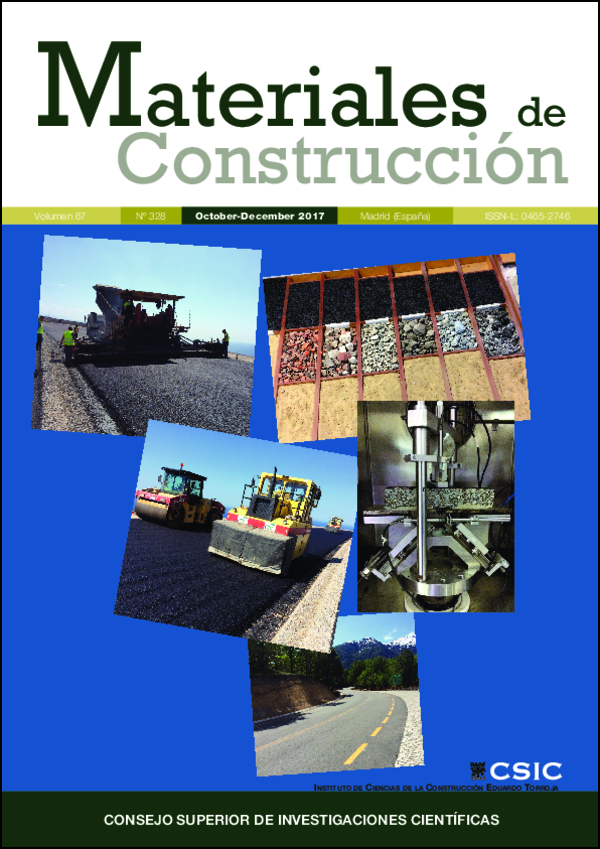Characterization of quality recycled gypsum and plasterboard with maximized recycled content
DOI:
https://doi.org/10.3989/mc.2017.06016Keywords:
Gypsum, Characterization, Physical properties, Mechanical properties, Flexural strengthAbstract
The quality of secondary materials is imperative to promote a circular economy. In order to improve the way in which the quality of recycled gypsum is assessed, European guidelines on recycled gypsum (RG) quality criteria have been outlined in the framework of the Life+ Gypsum to Gypsum (GtoG) project. Such GtoG guidelines, along with the European Standard on gypsum plasterboard EN 520, provided the basis for this study. During the GtoG project, gypsum recycling and plasterboard manufacturing processes were monitored by testing the gypsum feedstock and the plasterboard produced. The aim of this paper is to discuss the results obtained on relevant parameters that characterize gypsum as a secondary raw material, as well as the resulting product. The minimum requirements were fulfilled by 56% of the RG samples and 86% of the plasterboard with increased RG.
Downloads
References
Jiménez-Rivero, A.; García-Navarro, J. (2016) Indicators to Measure the Management Performance of End-of-Life Gypsum: From Deconstruction to Production of Recycled Gypsum. Waste Biomass Valoriz. 7, 913–927. https://doi.org/10.1007/s12649-016-9561-x
Jiménez Rivero, A.; Sathre, R.; García Navarro, J. (2016) Life cycle energy and material flow implications of gypsum plasterboard recycling in the European Union. Resour. Conserv. Recycl. 108, 171–181. https://doi.org/10.1016/j.resconrec.2016.01.014
Jiménez Rivero, A.; De Guzmán Báez, A.; García Navarro, J. (2015) Gypsum Waste: Differences across Ten European Countries. Int. J. Sustain. Policy Pract. 11 [4], 1–9.
The Council of the European Union. (2003) Council Decision of 19 December 2002 establishing criteria and procedures for the acceptance of waste at landfills pursuant to Article 16 of and Annex to Directive 1999/31/EC (2003/33/EC). Official Journal of the European Communities. L 11/27-11/49.
Plaza, C.; Xu Q.; Townsend, T.; Bitton, G.; Booth, M. (2007) Evaluation of alternative landfill cover soils for attenuating hydrogen sulfide from construction and demolition (C&D) debris landfills. J. Environ. Manage. 84 [3], 314–322. https://doi.org/10.1016/j.jenvman.2006.06.001 PMid:16890345
Ding, G.K.C. (2008) Sustainable construction-The role of environmental assessment tools. J. Environ. Manage. 86 [3], 451–464. https://doi.org/10.1016/j.jenvman.2006.12.025 PMid:17289255
Suárez, S.; Roca, X.; Gasso, S. (2016) Product-specific life cycle assessment of recycled gypsum as a replacement for natural gypsum in ordinary Portland cement: application to the Spanish context. J. Clean. Prod. 117, 150–159. https://doi.org/10.1016/j.jclepro.2016.01.044
Chandara, C.; Azizli, K.A.M.; Ahmad, Z.A.; Sakai, E. (2009) Use of waste gypsum to replace natural gypsum as set retarders in portland cement. Waste manage. 29 [5] 1675–9. https://doi.org/10.1016/j.wasman.2008.11.014 PMid:19131236
Kuttah, D.; Sato, K. (2015) Review on the effect of gypsum content on soil behavior. Transport. Geotechnics 4, 28–37. https://doi.org/10.1016/j.trgeo.2015.06.003
Jang, Y.-C.; Townsend, T. (2001) Sulfate leaching from recovered construction and demolition debris fines. Adv. Environ. Res. 5 [3], 203–217. https://doi.org/10.1016/S1093-0191(00)00056-3
GtoG project. (2013) Life+ Gypsum to Gypsum (GtoG) project 'From production to recycling: a circular economy for the European Gypsum Industry with the Demolition and Recycling Industry' LIFE11 ENV/BE/001039, http://gypsumtogypsum.org (retrieved 05. 12.16.)
GtoG project. (2015) DC2: Protocol of action B2.2: Quality criteria for recycled gypsum, technical and toxicological parameters LIFE11 ENV/BE/001039, http://gypsumtogypsum.org/documents/quality-criteria-for-recycled-gypsum-technical-and-toxicological-parameters.pdf (retrieved 05.12.16.).
CEN (2009) EN 520:2004+A1. Gypsum plasterboards - Definitions, requirements and test methods.
VGB (2008) VGB-M 701e. Instruction Sheet Analysis of Analysis of FGD Gypsum FGD gypsum.
CEN (2012) EN 933-1:2012. Tests for geometrical properties of aggregates - Part 1: Determination of particle size distribution - Sieving method.
CEN (2002) EN 13137:2002. Characterization of waste - Determination of total organic carbon (TOC) in waste, sludges and sediments.
CEN (2007) ISO 11885:2007. Water quality - Determination of selected elements by inductively coupled plasma optical emission spectometry (ICP-OES).
GtoG project. (2015) DB4: Report of Production Process Parameters LIFE11 ENV/BE/001039, http://gypsumtogypsum. org/documents/report-on-production-process-parameters.pdf (retrieved 05.12.16.).
WRAP; Environment Agency (2013) Quality Protocol. Gypsum. End of waste criteria for the production and use of recycled gypsum from waste plasterboard.
Bundesverband der Gipsindustrie e.V. (2013) Recycled gypsum (RC-gypsum). Initial test for recycling plants, quality management, quality requirements and analysis methods.
Beckert, J. (1990) Comparison of natural gypsum and FGD gypsum: studies for a comparative assessment of the health impact of natural gypsum and FGD gypsum from coal-fired power plants with a view to their use in the manufacture of building. materials. VGB technical scientific reports "Thermal power plants", 707.
GtoG project. (2013) DA1: Inventory of current practices LIFE11 ENV/BE/001039, http://gypsumtogypsum.org/ documents/deliverable-a1-report-on-current-practices.pdf (retrieved 05.12.16.).
Venta, G.J. (1997) Life cycle analysis of gypsum board and associated finishing products.
Roskill (2014) Gypsum and Anhydrite: Global Industry Markets and Outlook.
WRAP and Environmental Resources Management Ltd (ERM). (2008) Technical Report: Life Cycle Assessment of Plasterboard.
Henkels, P.J.; Gaynor, J.C. (1996) Characterizing synthetic gypsum for wallboard manufacture. ACS Division of Fuel Chemistry, Preprints 41 [2], 569–574.
WRAP; BSI (2013) PAS 109:2013. Specification for the production of reprocessed gypsum from waste plasterboard.
Published
How to Cite
Issue
Section
License
Copyright (c) 2017 Consejo Superior de Investigaciones Científicas (CSIC)

This work is licensed under a Creative Commons Attribution 4.0 International License.
© CSIC. Manuscripts published in both the print and online versions of this journal are the property of the Consejo Superior de Investigaciones Científicas, and quoting this source is a requirement for any partial or full reproduction.
All contents of this electronic edition, except where otherwise noted, are distributed under a Creative Commons Attribution 4.0 International (CC BY 4.0) licence. You may read the basic information and the legal text of the licence. The indication of the CC BY 4.0 licence must be expressly stated in this way when necessary.
Self-archiving in repositories, personal webpages or similar, of any version other than the final version of the work produced by the publisher, is not allowed.
















